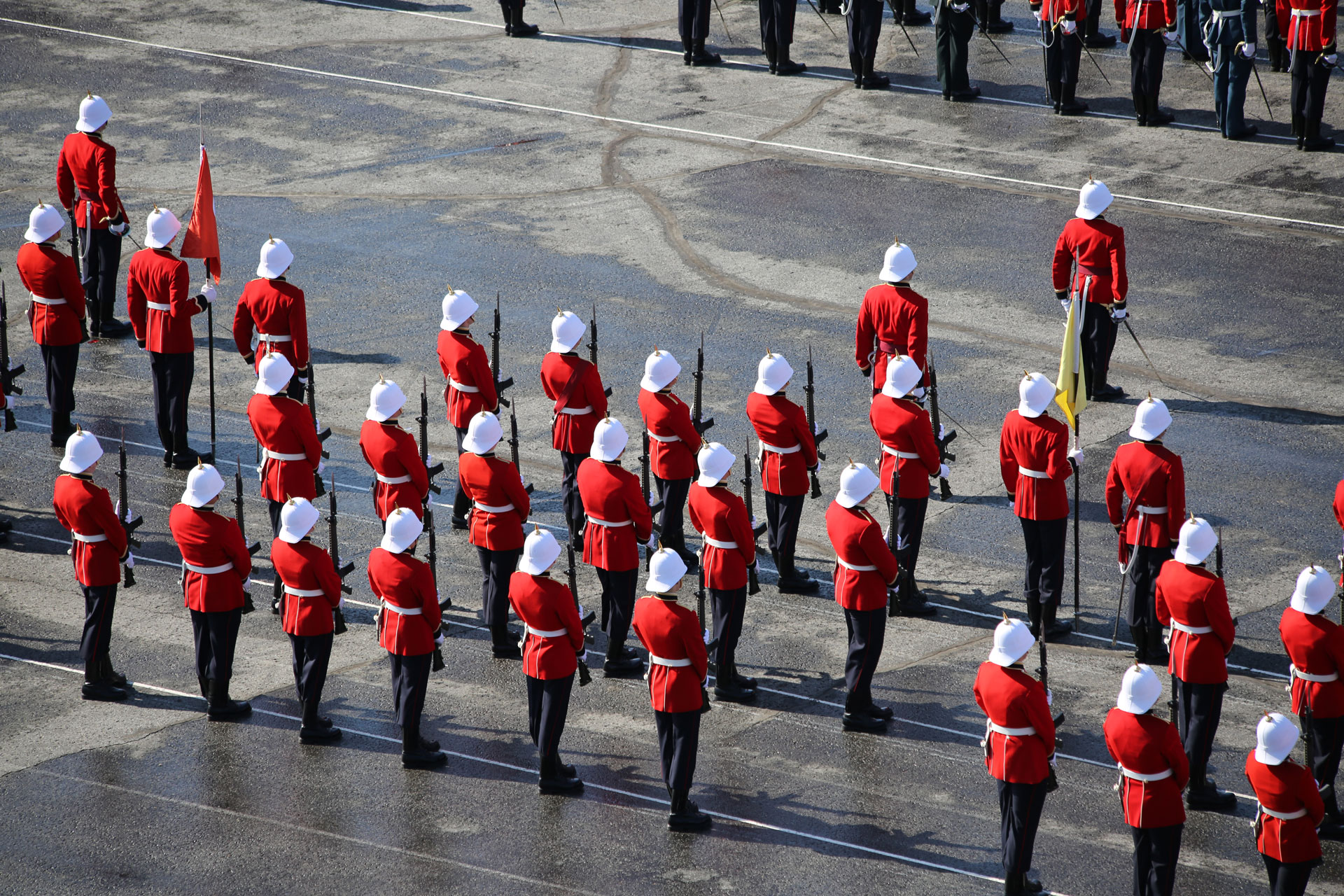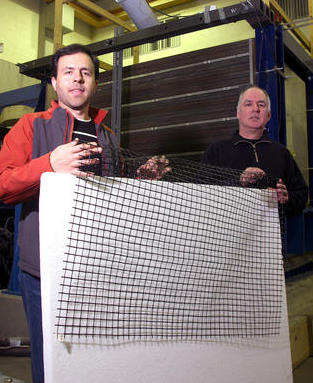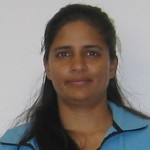
The meshing link
Article first appeared in the Kingston Whig Standard 19 January 2011 – By IAN ELLIOT

Rather than mess around with giant springs, counterweights and other load dampeners built into a large, heavy structure, Dr. Richard Bathurst and graduate student Saman Zarnani have taken a ground-up approach.
At the same RMC lab that first proved that thick, plastic foam sheets like the thermal insulation put around house foundations could dampen earthquake shock waves by acting as a pillow, the pair have developed an in-ground mesh that stabilizes earthen retaining walls and everything around them.
The two are sure the special mesh works. They just need to generate a mountain of data to prove it and demonstrate how it performs under various conditions to satisfy engineers, planners and building code authorities in two countries — not to mention the potential military clients.
“This is a high-performance plastic, it isn’t anything you’d ever find in a consumer product,” Bathurst said while holding a sheet of the plastic, a lightweight mesh reminiscent of snow fencing and that looks like steel rebar.
“This is flexible but very, very strong,” he said. “In some ways you could compare it to rebar for the soil.”
The research is being largely funded by Americans, who are increasingly paying Canadians to do specialized research in technical fields where their competency is above question and their projects benefit both nations because of climactic, geographical and social similarities.
The reason this work is being done at RMC is because of the massive shaking tables that sit on three feet of reinforced concrete in the basement of the engineering labs. There are only two such facilities in Canada and Kings -ton’s is the only one specifically designed to study earth movements and not buildings.
The smallest of the tables can hold an incredible 17 tonnes of soil and can be shaken like a paint can at a hardware store, with a wall inside equipped with monitors to measure real-time forces.
The tables have been used in other geosynthetic experiments over the past 30 years, for everything from permafrost studies to vibrating a component or structure to failure while measuring what is happening.
“This university has been at the front of geosynthetic research for the past three decades,” Bathurst said.
“People don’t think earthquakes are a big issue for this country, or just a problem for the west coast, but we have a lot of areas even in Ontario prone to earthquakes, places like the Ottawa Valley.”
The thick styrofoam cushion, which had its value as a dampener proved in this lab, is on the market and has already been installed on two new buildings in Vancouver, where it will be monitored over a long period.
The two researchers hope the mesh will be snapped up by builders if the studies proving its usefulness come through. It can be installed around existing structures, but that is much more expensive than adding it during construction — and Bathurst notes that among those watching most carefully is the military, which happens to own the very building in which Bathurst and Zarnani work.
“It makes a lot of sense for DND to have a great interest in this sort of technology because they are one of the biggest own-e rs of land and buildings in Canada,” Bathurst said. Source
_________________________________
Rhodes scholarship to Brendan Alexander RMC student from Stittsville
“Growing up in Stittsville has definitely had an impact on who I am today,” Brendan wrote in an email response. While he attended Ashbury College in Ottawa from grades 4 through 12, he remained very involved in a wide range of sports, camps and other Stittsville-based activities during his childhood.
24862 Brendan Alexander (RMC 2011)
_________________________________
RMC PROFESSOR RECEIVES INTERNATIONAL RECOGNITION

Dr. Chandra has been awarded the International Union of Pure and Applied Physics (IUPAP) Young Scientist Prize in Astrophysics for 2010. She was presented with the prize during the 25th Texas Symposium on Relativistic Astrophysics in Heidelberg, Germany, in December for her work on radio detection of distant gamma ray bursts and supernovae.
The award was presented by distinguished astrophysicist Virginia Trimble.
“I was honoured to receive this award from Virginia Trimble, a person whose work and career I have always admired,” said Dr. Chandra. “I am so happy that my work was noted and considered for this prestigious award.”
For Dr. Chandra’s colleagues, who she acknowledged for their “support and encouragement”, the award shows the high caliber of up and coming researchers at the College.
“The award of the International Union of Pure and Applied Physics young scientist prize to Dr. Poonam Chandra demonstrates the high international regard of astrophysics research at RMC,” said astronomer Dr. Gregg Wade, professor in the Department of Physics at RMC. “That the College is able to attract rising stars like Dr. Chandra strongly supports RMC’s research profile, and allows us to successfully compete with much larger institutes, both in Canada and abroad.”
Courtesy – Lieutenant Cynthia Kent, RMC Public Affairs
CKWS VIDEO
UNE PROFESSEURE DU CMR REÇOIT UNE RECONNAISSANCE INTERNATIONALE
KINGSTON, Ont. – Mme Poonam Chandra, Ph.D., professeure adjointe auxiliaire du Collège militaire royal (CMR) du Canada, s’est vu décerner un prix international pour son travail en astrophysique.
Mme Chandra a mérité le prix du jeune scientifique en astrophysique de l’Union internationale de physique pure et appliquée (UIPPA) en 2010. Ce prix lui a été remis lors du 25e Symposium du Texas sur l’astrophysique relativiste à Heidelberg, en Allemagne, en décembre dernier, pour son travail sur la radiodétection des sursauts gamma et des supernovæ distants.
Le prix a été présenté par l’éminente astrophysicienne Virginia Trimble.
« J’ai été honorée de recevoir ce prix des mains de Mme Virginia Trimble, dont j’ai toujours admiré le travail et la carrière », a dit Mme Chandra. « Je suis très heureuse que mon travail ait été remarqué et pris en compte pour ce prestigieux prix ».
Les collègues de Mme Chandra, qu’elle a remerciés de leur soutien et de leur encouragement, estiment que ce prix fait foi du calibre élevé des chercheurs prometteurs du Collège.
« Le prix du jeune scientifique de l’Union internationale de physique pure et appliquée décerné à Mme Poonam Chandra témoigne de la grande réputation internationale du programme de recherches en astrophysique du CMR », a dit l’astronome Gregg Wade, Ph.D., professeur du Département de physique du CMR. « Le fait que le Collège soit en mesure d’attirer des étoiles montantes comme Mme Chandra est excellent pour le profil de recherche du CMR et lui permet d’être compétitif face à des universités beaucoup plus grandes, tant canadiennes qu’étrangères ».

